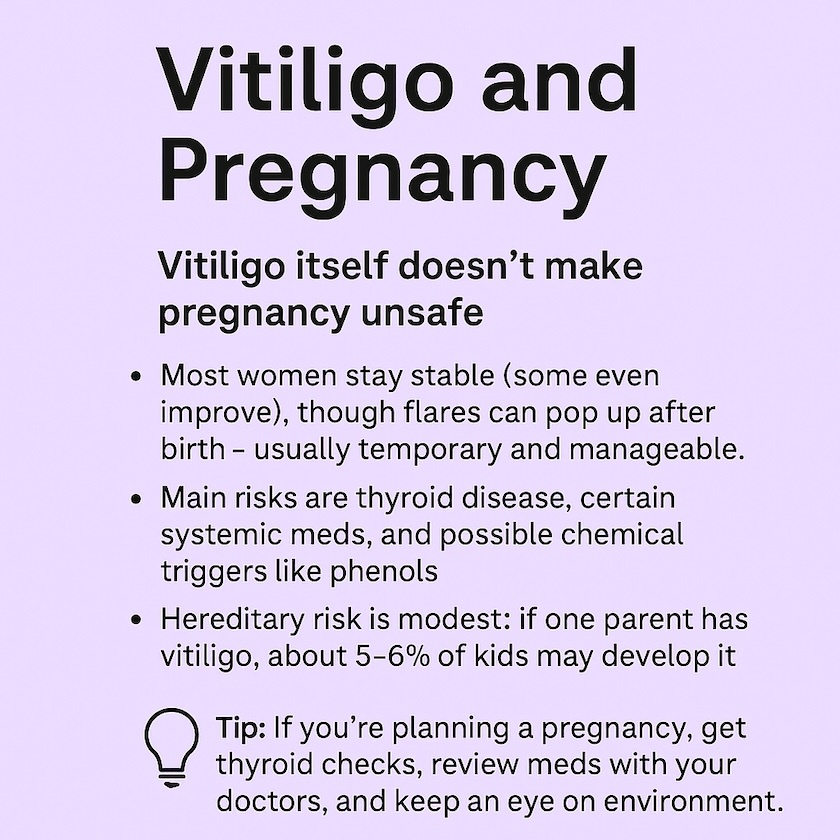New
Does vitiligo make pregnancy riskier?
Vitiligo is mostly a skin-limited autoimmune condition — it doesn’t directly harm fertility or pregnancy. But here’s the twist: vitiligo often comes with other autoimmune baggage, like thyroid disease, lupus, or type 1 diabetes. Those conditions, plus the medications used to treat them, are what can tilt pregnancy toward higher risks.
TL;DR—For the Quick-Scanners:
Vitiligo itself isn’t dangerous to mother or baby. Most women stay stable (some even improve), though flares can pop up after birth. The main concerns are thyroid disease, certain systemic meds, and possible chemical triggers. Miscarriage risk may be slightly higher, but other complications aren’t consistently linked. Kids’ risk is modest—about 5–6% if a parent has vitiligo. With thyroid checks, med review, and good prenatal care, most pregnancies go smoothly.
So what do we know about pregnancy with vitiligo?
Small clinical series suggest (1, 2) that many women with vitiligo actually do well in pregnancy: their skin remains stable or even improves, likely due to immune changes that make the body more tolerant. After delivery, some women notice flares when the immune system “rebounds.” These flares are often temporary and can usually be managed with standard treatments like UVB or corticosteroids that are generally considered safe.
Large national database studies add nuance. A Korean study linked vitiligo to higher miscarriage rates and fewer live births. A Taiwanese cohort found a modestly higher miscarriage risk, but no consistent increase in preterm birth, pre-eclampsia, or stillbirth. An Israeli study reported no extra risk at all. Taken together, the only signal that repeats is a small but possible bump in miscarriage risk. Everything else is inconclusive.
Hereditary risk: will my child have vitiligo?
Vitiligo is genetic, but not in the simple one-gene, yes-or-no sense. It’s multifactorial — genes create a predisposition, while environment acts as the trigger.
- Children with one affected parent face about a 5–6% lifetime risk of vitiligo, compared to ~1% in the general population. That’s a five- to six-fold increase, but it still means more than 90% of children will not develop it.
- Roughly 20% of people with vitiligo have a first-degree relative with the condition. Yet even identical twins only show about 23% concordance — clear evidence that environment, stress, or other factors are just as important as genes.
- If multiple autoimmune conditions run in the family, the risk of vitiligo or another autoimmune disorder may be somewhat higher.
- More than 50 genes have been linked to vitiligo risk. About 70% of the genetic risk comes from common variants, with rare variants contributing the remaining 30%. Most involve immune regulation and melanocyte biology.
Why this matters for clinicians
- Always screen for thyroid disease — ideally both TSH and thyroid antibodies — as part of preconception or antenatal care. Hypothyroidism and hyperthyroidism can complicate pregnancy.
- Review medications: topical corticosteroids and light therapy (narrowband UVB) are generally considered safe. Systemic immunosuppressants and biologics need case-by-case assessment, ideally before conception.
- Coordinate care: dermatologists, obstetricians, and endocrinologists should collaborate to provide joined-up care.
- Manage expectations: reassure patients that vitiligo itself is not dangerous, while also flagging that miscarriage risk is less clear.
Environmental caution: phenols and ZIP codes
Genetics aren’t the whole story. Where you live and what you’re exposed to can matter too. Research has linked certain industrial chemicals — especially phenols found in hair dyes, adhesives, and disinfectants — to triggering vitiligo in susceptible people. Studies have also shown ZIP code effects, where living in areas with higher chemical exposure or environmental stressors can shape how severe or widespread vitiligo becomes.
Why now?
That’s why a new BMJ Open scoping review is timely. The team plans to map every study to date on vitiligo and pregnancy, looking at both maternal outcomes (like gestational diabetes, hypertension, hemorrhage) and neonatal outcomes (growth restriction, NICU admissions, stillbirth). The goal isn’t final answers, but a clearer picture of the evidence gaps.
Takeaway
Vitiligo itself isn’t a pregnancy risk. The main concerns are comorbid autoimmune conditions, medication choices and environmental triggers. Even with the modest miscarriage risk, overall pregnancy outcomes for women with vitiligo are generally good. With good pre-pregnancy planning, thyroid checks, and coordinated care, most women with vitiligo can expect safe pregnancies and healthy babies.

Yan Valle
Professor h.c., CEO VR Foundation | Author, A No-Nonsense Guide to Vitiligo
Dig deeper:
- Vitiligo's Unexpected Health Benefits
- Vitiligo’s White Armour: A Shield Against Mortality & Diseases?
- Podcast: Vitiligo and Pregnancy: The Complex Connection (Ep. 14)

FAQOther Questions
- Polypodium leucotomos as an adjunct treatment for vitiligo?
The tropical fern Polypodium leucotomos (also known as Polypodium aureum) and its relative Polypodium decumanumhave shown potential benefits for managing vitiligo and other auto...
- Is there a link between vitiligo and depression?
Depression and anxiety are often linked with vitiligo, significantly impacting a person’s quality of life. The connection stems from the shared origin of the skin and brain duri...
- Vitiligo and hearing loss: any connection?
Vitiligo is primarily recognized for causing skin discoloration, but it can also impact melanocytes in unexpected areas, such as the inner ear. This raises questions about wheth...
Though it is not always easy to treat vitiligo, there is much to be gained by clearly understanding the diagnosis, the future implications, treatment options and their outcomes.
Many people deal with vitiligo while remaining in the public eye, maintaining a positive outlook, and having a successful career.
Copyright (C) Bodolóczki JúliaBy taking a little time to fill in the anonymous questionnaire, you can help researchers better understand and fight vitiligo.
